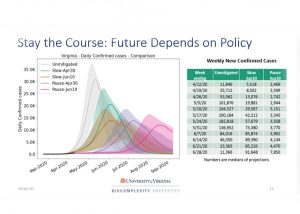 By Brandon Martin
By Brandon Martin
Social distancing efforts may be working according to research data from the University of Virginia’s Biocomplexity Institute and the nonprofit Research and Development (RAND) Corporation.
Gov. Ralph Northam also partnered with both the institute and RAND, who pride themselves on their use of analytics to make policy based decisions.
“We are proud to be working with some of the top minds in the country on these projections,” Northam said. “While the data is limited, we can draw a few key conclusions: First, social distancing is important, and it’s working in Virginia. Second, while we continue to work closely with our hospital systems and other healthcare partners to prepare for a potential surge in acute cases, we are optimistic about our statewide hospital bed capacity. Finally, it’s clear we need to be responsible about how we ease restrictions, so we can keep Virginians safe and protect public health.”
The models presented on April 13, showed that social distancing that began mid-March have caused a pause in the growth of COVID-19 cases for Virginia. They also suggest that the state’s hospital bed capacity will be sufficient in the immediate future.
The good news doesn’t mean that social distancing can be relaxed yet, according to Nancy Bell, public information officer for the West Piedmont Health District.
“This is an ever-changing situation and is very much reliant upon people continuing to follow the stay-at-home order,” she said. “If we relax our standards, the progress we are making could be lost, and all assumptions about when we return to business as usual change.”
Dr. Kerry Gateley, health director at the Virginia Department of Health explained the reasoning a little further.
“For example, we are beginning to understand that many people with no symptoms are contagious and can infect others without knowing it,” he said. “In the absence of a vaccine, social distancing is our best weapon against it. China basically had the virus under control. Since ending stay-at-home orders, leaders there are noticing a resurgence. How significant remains to be seen.”
The Secretary of Health and Human Resources Daniel Carey, said that the state’s next step will be grounded in science and data.
“These models change every day, but we can use various models to help inform a range of outcomes we may be facing so we can make sure that Virginia is ready for all possible scenarios,” Carey said. “Like every other state and many other countries, we are preparing for how we can move forward in a way that does not trigger another medical surge.”
The UVA Biocomplexity Institute developed the model including variables such as transmissibility, incubation period, population density and social behavior.
The Institute modeled five potential scenarios, exploring slowing growth vs. pausing growth with social distancing in place until April 30 and June 10 compared to no mitigation.
“Even without perfect projections, we can confidently draw conclusions,” said Bryan Lewis, Research Associate Professor for the Network Systems Science and Advanced Computing division for the Institute. “We know that social distancing is working and lifting restrictions too early can lead to a second surge. We will continue to improve our models as more data become available. We plan to incorporate outcomes specific by age, integrate the role of seasonality, and analyze mitigation techniques such as a Test-Trace-Isolate approach.”
The model developed by the Institute and RAND isn’t the only one according to Carter Price, a senior mathematician at the RAND.
“Each of these models has strengths and weaknesses, and they are likely to evolve as more and better data become available,” Price said. “We are helping the leadership of the
The UVA Biocomplexity Institute has worked on epidemic modeling and mitigation since 2002. Their work has supported the U.S. federal government and other countries with other outbreaks such as H5N1, the 2009 H1N1 pandemic, the MERS outbreak of 2012, and the Ebola outbreaks of 2014 and 2019.



